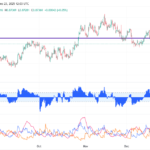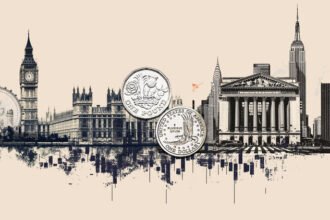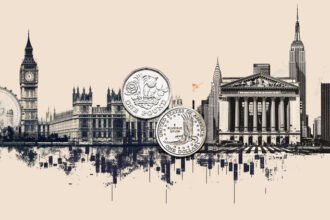The Pound Sterling (GBP) faces selling pressure against its peers on Tuesday after the release of the United Kingdom (UK) labor market data for the three months ending in August.
The Office for National Statistics (ONS) reported that the ILO Unemployment Rate rose to 4.8%, higher than estimates and the prior reading of 4.7%. Fresh workers added during the period came in at 91K, much less than the 232K jobs added in the three months ending July.
Additionally, Average Earnings Including Bonuses, a key measure of wage growth, slowed to 4.7% on year, as expected, against the former reading of 4.8%. This is the lowest figure seen since May 2022. Average Earnings Excluding Bonuses rose at a faster pace of 5%, higher than expectations and the prior release of 4.7%.
Signs of a cooling UK labor market have boosted expectations for more interest rate cuts by the Bank of England (BoE) in the remainder of the year. Traders expect the BoE to cut interest rates further by 46 basis points (bps) this year, according to Reuters.
For fresh cues on the monetary policy outlook, investors will focus on speeches from BoE Monetary Policy Committee (MPC) member Alan Taylor and Governor Andrew Bailey, which are scheduled later on Tuesday during the North American session. Investors will closely monitor their words to get cues about whether the UK central bank will cut interest rates again this year.
On Monday, BoE MPC member Megan Greene argued in favor of reducing interest rates further, citing that the monetary policy is still restrictive. However, she remained cautious about inflation returning towards the 2% target.
Pound Sterling Price Today
The table below shows the percentage change of British Pound (GBP) against listed major currencies today. British Pound was the weakest against the Japanese Yen.
| USD | EUR | GBP | JPY | CAD | AUD | NZD | CHF | |
|---|---|---|---|---|---|---|---|---|
| USD | 0.14% | 0.51% | -0.14% | 0.23% | 0.94% | 0.63% | 0.04% | |
| EUR | -0.14% | 0.37% | -0.25% | 0.08% | 0.85% | 0.50% | -0.10% | |
| GBP | -0.51% | -0.37% | -0.63% | -0.27% | 0.47% | 0.17% | -0.46% | |
| JPY | 0.14% | 0.25% | 0.63% | 0.37% | 1.06% | 0.73% | 0.13% | |
| CAD | -0.23% | -0.08% | 0.27% | -0.37% | 0.75% | 0.40% | -0.19% | |
| AUD | -0.94% | -0.85% | -0.47% | -1.06% | -0.75% | -0.35% | -0.93% | |
| NZD | -0.63% | -0.50% | -0.17% | -0.73% | -0.40% | 0.35% | -0.59% | |
| CHF | -0.04% | 0.10% | 0.46% | -0.13% | 0.19% | 0.93% | 0.59% |
The heat map shows percentage changes of major currencies against each other. The base currency is picked from the left column, while the quote currency is picked from the top row. For example, if you pick the British Pound from the left column and move along the horizontal line to the US Dollar, the percentage change displayed in the box will represent GBP (base)/USD (quote).
Daily digest market movers: US Dollar gains on receding US-China trade tensions
- The Pound Sterling slides to near 1.3250 against the US Dollar (USD) during Tuesday’s European session after the release of the UK employment data. Apart from weakness in the Pound Sterling, a broadly outperforming US Dollar has also been a major drag on the GBP/USD pair.
- The US Dollar Index (DXY), which tracks the Greenback’s value against six major currencies, trades firmly near the 10-week high around 99.50.
- The US Dollar exhibits strength amid easing trade tensions between the United States (US) and China. Earlier in the day, China’s Ministry of Commerce stated that high-level trade talks with Washington are ongoing. However, it warned that they would respond if the White House continues with “discriminatory practices” and “abusing export controls”. “If there’s a fight, we’ll fight to the end; if there’s a talk, the door is open,” a spokesperson said, Reuters reported.
- US Treasury Secretary Scott Bessent has also confirmed a meeting between President Donald Trump and Chinese leader Xi Jinping in late October in South Korea.
- On the domestic front, investors await the speech from Federal Reserve (Fed) Chair Jerome Powell at the National Association for Business Economics (NABE) Annual Meeting in Philadelphia at 16:20 GMT. Investors will scrutinize Powell’s words to get clues about the pace at which the Fed will continue loosening its monetary policy in the near term. Fed’s Powell is expected to provide cues about the pace of the monetary-easing cycle for the remainder of the year.
- According to the CME FedWatch tool, traders see a 94% chance that the Fed will reduce interest rates by 50 basis points (bps) to 3.50%-3.75% until the end of the year.
Technical Analysis: Pound Sterling slumps on H&S breakdown
-1760424603974-1760424603980.png&w=1536&q=95)
The Pound Sterling slumps under 1.3300 against the US Dollar (USD) on Tuesday. The outlook for the GBP/USD pair has turned bearish as it has broken down from a Head and Shoulder (H&S) chart formation on the daily time frame.
A declining 20-day Exponential Moving Average (EMA) around 1.3418 also suggests that the near-term trend is bearish.
The 14-day Relative Strength Index (RSI) trades below 40.00, suggesting a strong bearish momentum.
Looking down, the August 1 low of 1.3140 will act as a key support zone. On the upside, the psychological level of 1.3500 will act as a key barrier.
Employment FAQs
Labor market conditions are a key element to assess the health of an economy and thus a key driver for currency valuation. High employment, or low unemployment, has positive implications for consumer spending and thus economic growth, boosting the value of the local currency. Moreover, a very tight labor market – a situation in which there is a shortage of workers to fill open positions – can also have implications on inflation levels and thus monetary policy as low labor supply and high demand leads to higher wages.
The pace at which salaries are growing in an economy is key for policymakers. High wage growth means that households have more money to spend, usually leading to price increases in consumer goods. In contrast to more volatile sources of inflation such as energy prices, wage growth is seen as a key component of underlying and persisting inflation as salary increases are unlikely to be undone. Central banks around the world pay close attention to wage growth data when deciding on monetary policy.
The weight that each central bank assigns to labor market conditions depends on its objectives. Some central banks explicitly have mandates related to the labor market beyond controlling inflation levels. The US Federal Reserve (Fed), for example, has the dual mandate of promoting maximum employment and stable prices. Meanwhile, the European Central Bank’s (ECB) sole mandate is to keep inflation under control. Still, and despite whatever mandates they have, labor market conditions are an important factor for policymakers given its significance as a gauge of the health of the economy and their direct relationship to inflation.





















